|
|
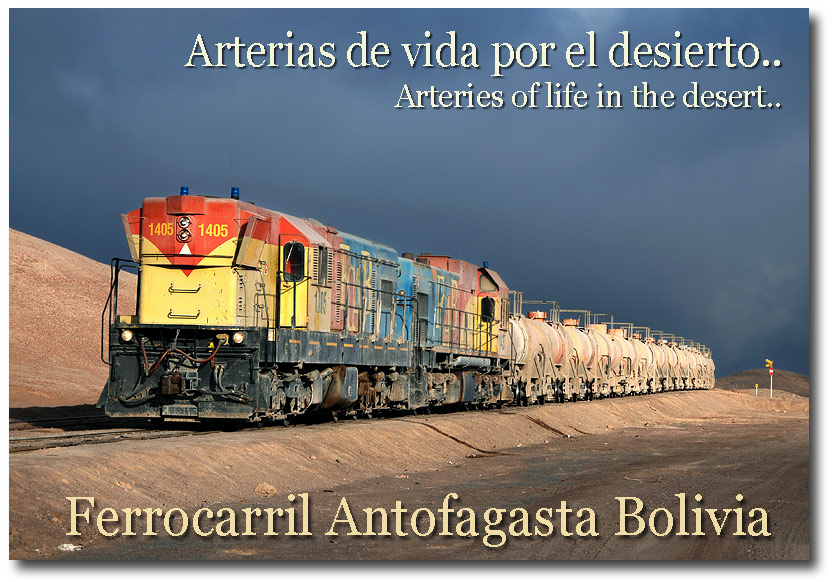 |
|
Diamond
in the Desert: The FCAB in Northern Chile is not only one of the
busiest railroads in South America, but also one of the most efficent
and profitable ones. Under dramatic looking clouds,
FCAB GR12U #1405 from 1961 and #1437 ex. Westrail (Australia) wait at cumbre
pass for the uncoupling the helpers and for a crossing. 13.12.2009. Diamant
in der Wüste: Die FCAB im Norden Chiles is nicht nur eine der
geschäftigsten Eisenbahnen Südamerikas, sonder wohl auch eine der
effizientesten und profitabelsten. Unter
einer dramatisch wirkenden Wolkenformation warteten am 13.12.2009 die FCAB GR12U Nr. 1405 und 1437 ex.
Westrail (Australien) in der Ausweichstation Cumbre zwischen
Mejillones - Prat auf einen Kreuzungszug.
|
|
|
|
|
|
|
|
|
The
FCAB is certainly a very positive example of
Railroad development in Latin America. Founded in 1888 as Ferrocarril
Antofagasta Bolivia, the company today is focused entirely on
freight traffic, being one of the busiest and best organized Railroads
in South America. The Railroad which today belongs to Antofagasta plc,
a large mining company listed on the Stock Exchange, is probably the
most profitable one in South America. FCAB has become a principal
carrier in northern Chile, employing 830 staff and running a Network
of 900km.
The
meter gauge railway runs on one route from the Pacific port of
Antofagasta south-east towards the Argentine border at Socompa Pass
(over Ferronor tracks between Augusta Victoria and Escondida), and
north-east to the Bolivian border at Ollagüe on the second.
FCAB’s
main business is the transport of copper and sulfuric acid from and to
the El Abra, Escondida, Zaldivar, Lomas Bayas, El Tesoro, Billiton’s
Spence and Chuquicamata mines. The latter is the largest and deepest
open copper mine in the world and operates an own industrial railroad
system. Additional tonnage comes from mines in Bolivia, shipping
silver, zinc and lead down the Andes from San Cristóbal/ Uyuni in
Bolivia to the port of Antofagasta.
In
recent years, hundreds of kilometers of 65 and 75 pound-rails have
been replaced by heavier rails, reflecting the continuous increase in
axle loads and traffic levels. At Baquedano, located in the middle of
the desert some 60km north-east of Antofagasta, there is a junction
with Ferronor.
|
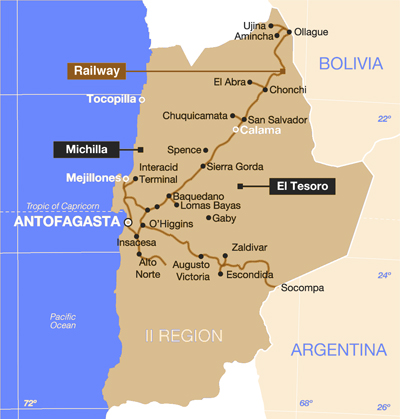 |
|
|
Map
of the FCAB in Northern Chile with the many mines it serves.
Karte der FCAB im
Norden Chiles mit den zahlreichen Minen, welche die Bahn
bedienet. |
|
|
|
|
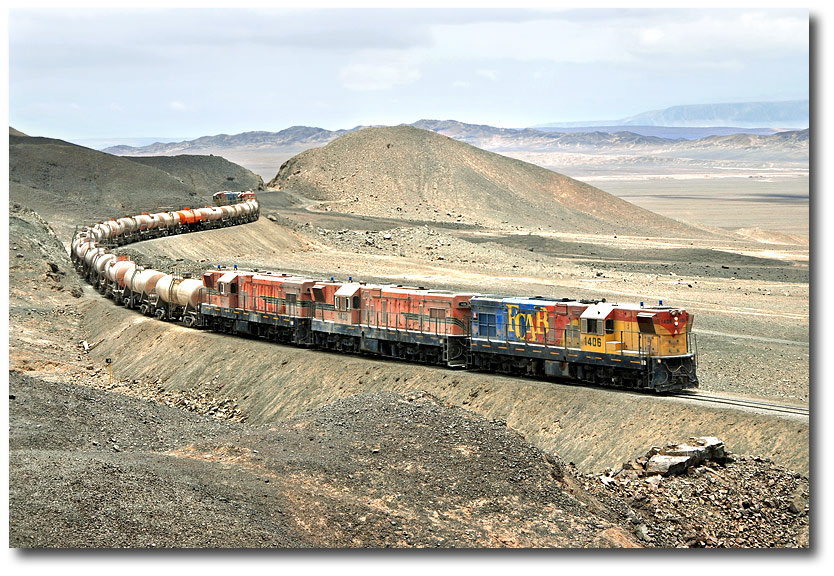 |
|
Within
the last 15 years, annual traffic levels transported by the FCAB had
more than quadrupled from 1.3 million tons to 5.6 in 2008.
Consequently, the FCAB had to acquire additional motive power over the
years. This is reflected by this picture, where FCAB GR12UD #1406, delivered 1964 directly to the
railroad,
heads a train together with #1438, acquired from Colombia, and #1411 from
chilean state railway. At the rear end, #1440 ex. Colombia and #1446
ex Queensland Railways help to push the train over the grade of
the Cumbre-Pass between Mejillones and Prat. 13.12.2009
Während der letzten 15 Jahre hatten
sich die jährlichen Transportmengen auf der FCAB praktisch
vervierfacht. Deshalb war die FCAB gezwungen, immer wieder neue
Triebfahrzeuge hinzuzukaufen. Dies veranschaulicht auch obiges Bild: Die 1964 direkt an die FCAB gelieferte EMD GR12UD
(#1406) führt zusammen
mit der aus Kolumbien gekauften Lok 1438 und von der Staatsbahn
übernommenen Lok 1411 einen beladenen Kesselwagenzug. Am Schluss des Zuges helfen
#1440, ebenfalls aus Kolumbien und die #1446 ex. Queensland Railways
(Australien) mit, den Zug über die langen Rampen der Gebirgsstrecke zwischen
Mejillones und Prat zu befördern.
|
|
|
|
|
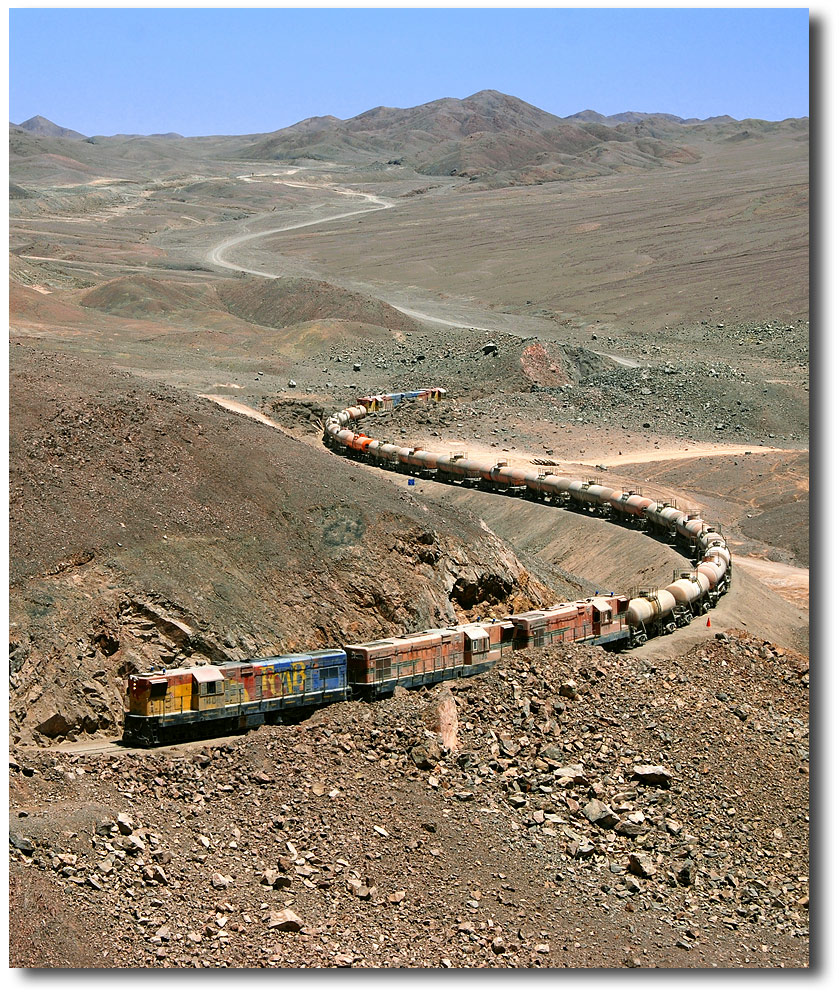 |
|
In the nineties of last
century, the FCAB Mejillones - Prat line, abandoned in 1919, was rebuilt, allowing trains from
Mejillones to the mines to bypass Antofagasta. The shortcut avoids the transport of dangerous goods through the densely
populated
area altogether. Copper production requires large quantities of sulphuric acid, which is
transported by the FCAB from interacid port of Mejillones to dedicated acid-terminals near the mines. On the horseshoe
curves below the summit of the line at 900m.a.s.l, five EMD units struggle
with a loaded train carrying sulphuric acid. December 13, 2009. Die
1919 aufgelassene FCAB Strecke Mejillones - Prat wurde in den neunziger
Jahren neu erstellt, um den Zügen vom Hafen
Mejillones eine direkte Verbindung zu den zahlreichen Minen in der Atacama Wüste unter
Umgehung der Stadt Antofagasta zu ermöglichen. Damit braucht die in
grossen Mengen zur Kupferproduktion benötigte
Schwefelsäure nicht durch das dicht besiedelte
Gebiet von Antofagasta transportiert zu werden. Fünf EMD Lokomotiven
kämpfen hier mit einem beladenen 'tren acido' über die
Rampe unweit Cumbre, dem Scheitelpunkt der Strecke auf rund 900m.ü.M.
13.12.2009
|
|
|
|
|
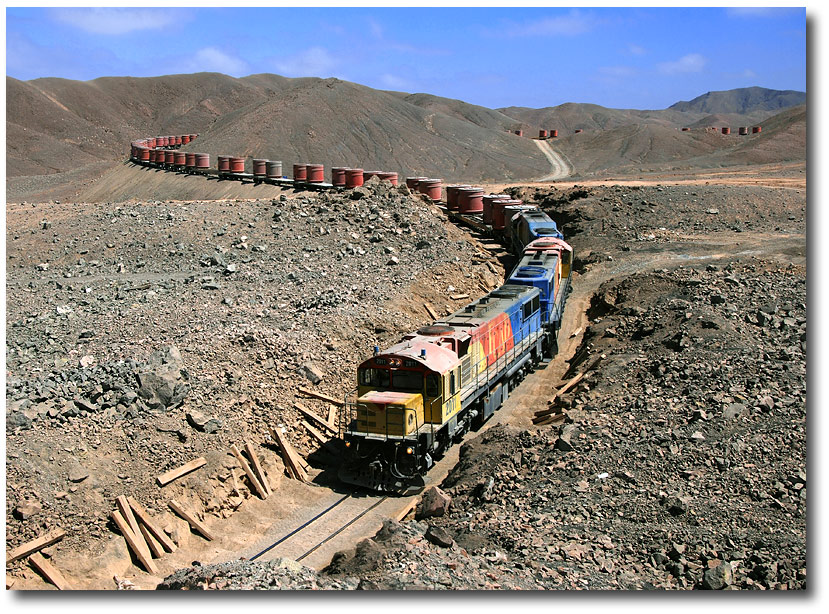
|
|
A 3000 ton mineral-train
with 50 cars, carrying silver, zinc and lead concentrate from
Bolivia to the Pacific Ocean,
crawls down the horseshoe curves of the Cumbre pass between Prat and
Mejillones. We called
the section Chilean "Jing Peng" for its double horseshoe curves and its
barren mountain scenery. 13.12.2009
Ein
3000-Tonnen-Errzzug mit 50 Wagen, der Silber-, Zink- und Blei-Konzentrat aus Bolivien
transportiert, fährt langsam talwärts durch die Kehrschleifen des Cumbre - Pass zwischen Prat und Mejillones. Wir nannten diesen
Abschnitt wegen der Linienenführung und der
Gebirgslandschaft den Chilenischen "Jing Peng".
|
|
|
|
|
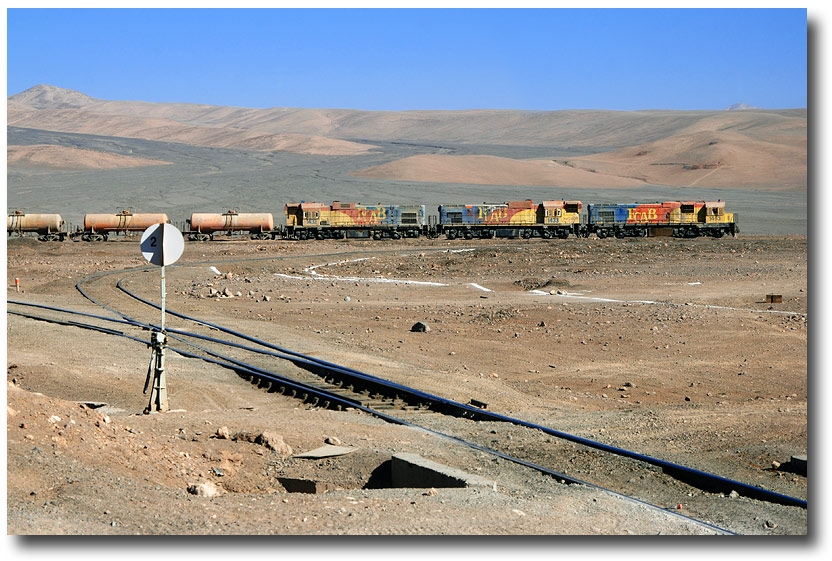
|
|
At Prat, the
track from Mejillones connects with the Antofogasta
- Calama line. As everywhere on the FCAB, switches are hand operated
and there are no signals, because all movements are radio controlled.
A tank train with sulfuric acid had just arrived and was then pushed back
into to the terminal for unloading the chemicals. 12.12.2009
In Prat trifft die Strecke von Mejillones
auf die Linie
Antofagasta - Calama. Wie auf der ganzen FCAB sind auch hier
ausschliesslich Handweichen anzutreffen und keinerlei Signale; der
gesamte Betrieb wird heute über Funk geregelt. Ein
Schwefelsäure-Kesselwagenzug war soeben eingetroffen und wird nun rückwärts in die
Verladegeleise zum Chemikalien-Terminal geschoben.
|
|
|
|
|
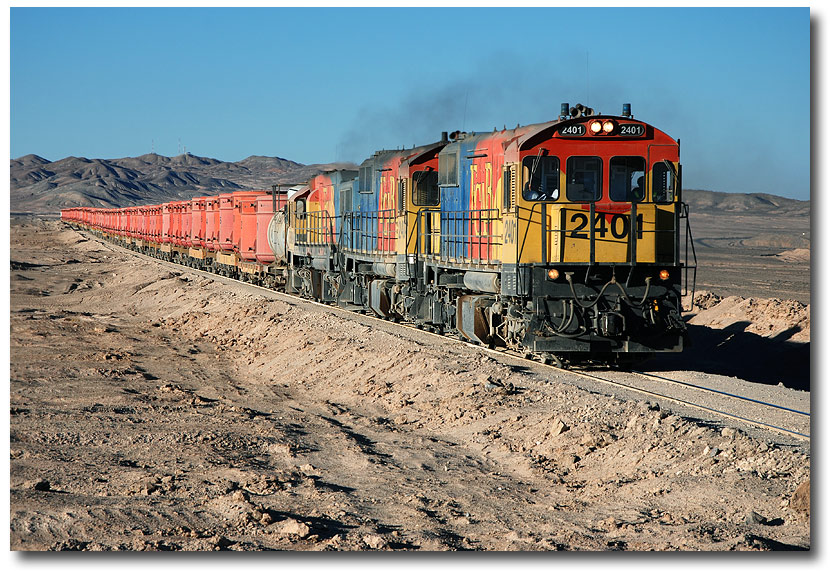 |
|
The
Atacama Desert is one of the most arid places on earth; some areas have never
seen any rain in history. In the lunar-esque landscape near Calama, an
eastbound approached with mineral containers for Bolivia. 15.12.2009
Die Atacama Wüste gilt als das
trockenste Gebiet der Erde. Manche Orte haben noch überhaupt nie Regen gesehen. In der mondartigen Landschaft unweit Calama
nähert sich ein Zug mit Behältern für den Transport von
Edelmetallen aus Bolivien.
|
|
|
|
|
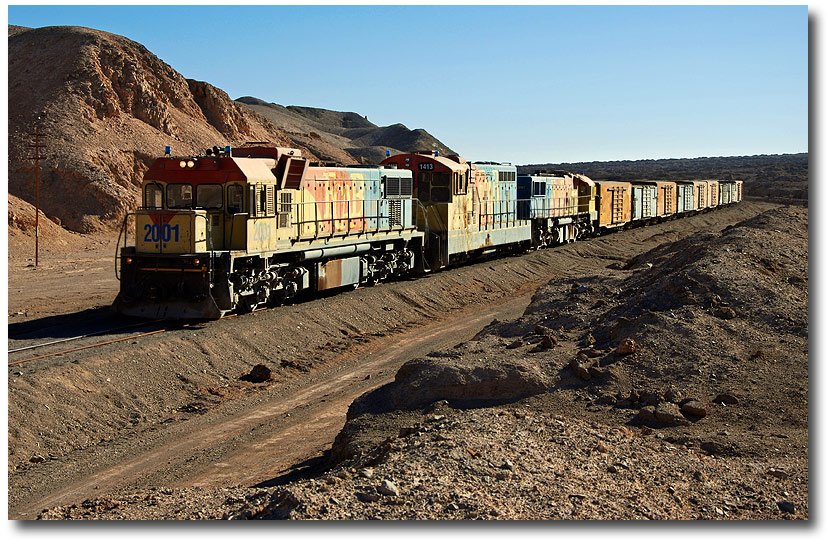 |
|
The
Profile of FCAB motive power and the heavy trains make one to forget that the
railroad is just metre gauge. The speed of the
trains, though, is relatively low, so it takes them about 16 hours for
the 150-miles-run from Mejillones to Calama and about 24 hours to Ollagüe
at the Bolivian border depending on load and crossings on the line. It
is no surprise therefore that we cought up the same train we saw the day
before at the Ascotán pass some 16 hours later down at Sierra Gorda... 15.12.2009 Das
Profil der FCAB Lokomotiven und die schweren Züge lassen einen fast
vergessen, dass die Bahn meterspurig ist. Die gefahrenen
Geschwindigkeiten sind jedoch relativ gering. Ein Zug von
Mejillones ins 250km entfernte Calama benötigt rund 16 Stunden, bis zur
Grenze nach Bolivien sind es gar rund 24 Stunden je nach Last und
Kreuzungshalten unterwegs. So erstaunt es nicht, dass wir den selben
Zug, den wir Tags zuvor am Ascotán Pass aufgenommen hatten, rund 16
Stunden später unterhalb Sierra Gorda
wieder einholten...
|
|
|
|
|
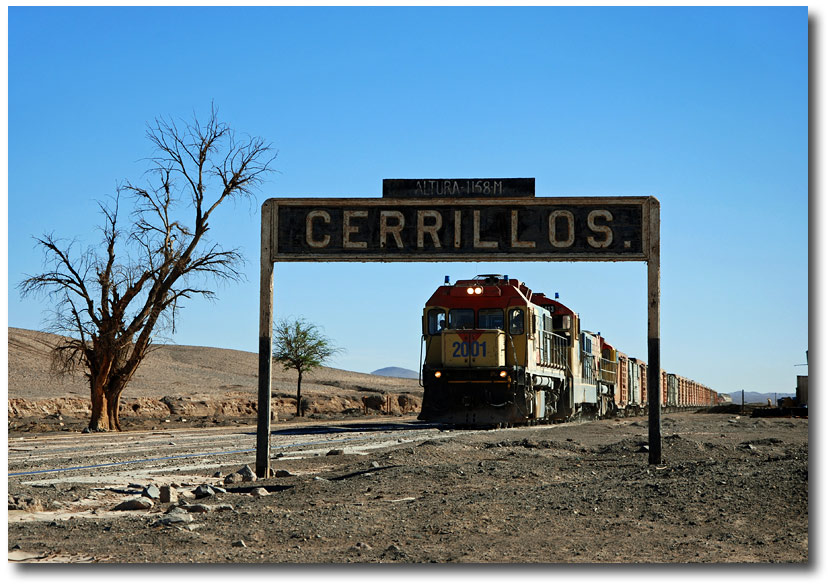 |
|
Where
there is water, there is live. Despite its extreme aridity, the
Atacama Desert has sustained humans for thounsands of years. The
earliest known people were the Chinchorro. Later, irrigated
agricultural practices adopted from the Tiwanaku culture in the Andes
allowed life in the desert. 15.12.2009 Wo
Wasser ist, ist Leben. Trotz ihrer extremen Trockenheit ist die
Atacama Wüste seit jahrtausenden schon von Menschen bewohnt. Die
älteste bekannte Kultur waren die Chinchorro. Später adaptierten die Atacameño von der Tiwanaku Kultur im Andenhochland
Bewässerungssysteme und Anbautechniken, die ihnen das Leben in der
Wüste erleichterten.
|
|
|
|
|
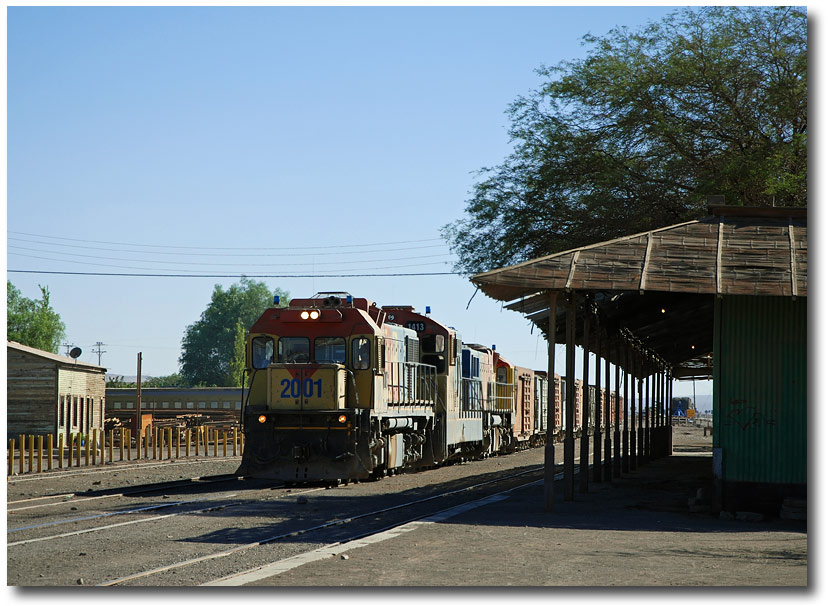 |
|
Baquedano
with its wooden station building is a relict from past times, when
trains from Ferrcarril del Norte, runing over 1000 miles from La Calera
(northwest of Santiago) to Iquique connected here with FCAB passengers
to Bolivia. The
station is situated between FCAB tracks and those of todays Ferronor. The difference between the two railroads could
hardly have been any more pronounced: While FCAB has had centralized train control
for years, leaving virtually all stations unmanned, showed Ferronor quite
another picture. Numerous
derelict freight and passenger cars were dumped on the tracks, and even
though there had not been any regular traffic for months, almost half
a dozen railwaymen could be encountered in the office! 15.12.2009 Baquedano
mit seinem hölzernen Bahnhof
ist ein Relikt aus
vergangenen Zeiten, als hier von den Zügen der meterspurigen Ferrocarril del Norte, die
einst über 1700 Kilometer von La Calera (nordwestlich von Santiago) bis Iquique verkehrten, auf die Züge der FCAB nach
Bolivien umgestiegen werden konnte. Links vom mittig angelegten Bahnhof
befinden sich die Gleise der FCAB, rechts die Anlagen der heutigen
Ferronor. Der Unterschied zwischen den beiden Bahnen könnte kaum
grösser sein: Während das tadellos gepflegte, dicht befahrene, rund
900km lange FCAB Streckennetz weitgehend rationalisiert ist und somit
auch dieser wichtige Bahnhof bei der FCAB ohne Personal auskommt,
waren auf der Ferronor-Seite, wo zahlreiche alte, offensichtlich seit
Jahren abgestellte Güter- und Personenwagen herumstanden und seit Monaten kein planmässiger Zug mehr
verkehrte gegen ein halbes dutzend Bedienstete anzutreffen!
|
|
|
|
|
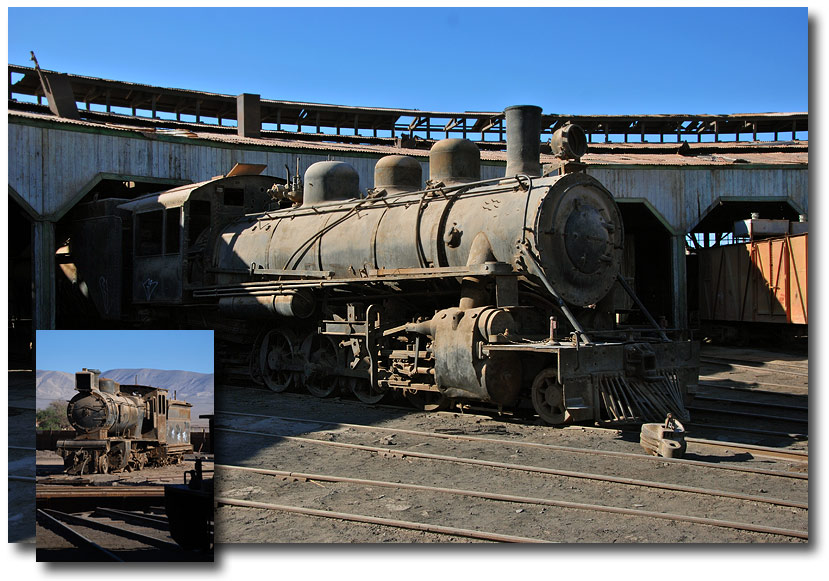 |
|
A
visit of Baquedano
is like a jouney into the past: What is locally called a
'railroad museum' is actually the remnant of a
once important junction, where everything looks as it would have been
just left behind a
few decades ago: A locomotive roundhouse with various steam engines, water tower, treatment facilities and a large workshop that
appears as workers just had dropped their tools the day before...
The movie clip Museo
Ferrocarril Baquedano provides a taste of the glory days of steam in
the Norte Grande and the clip tren
del desierto shows what can be found at Baquedano today.
13.12.2009 Ein
Besuch von Baquedano ist eine Reise in
die Vergangenheit: Was dort 'Bahnmusuem' genannt wird,
ist eigentlich mehr eine Art Geisterstadt oder Überbleibsel eines einst wichtigen
Verzweigungsbahnhofes, wo alles aussieht, als wäre es vor 40 Jahren
einfach liegen gelassen worden: Ein Rundlokschuppen mit diversen
abgestellten Loks und Wagen, Wasserturm und Behandlungsanlagen und
eine umfangreiche Werkstätte, wo man glaubt, die Arbeiter hätten
gerade gestern erst ihre Werkzeuge fallen gelassen. Ein Film
Museo
Ferrocarril Baquedano veranschaulicht, wie es zu Dampfzeiten hier
einmal ausgesehen hat und der Clip tren
del desierto zeigt, was man in Baquedano heute noch entdecken kann.
|
|
|
|
|
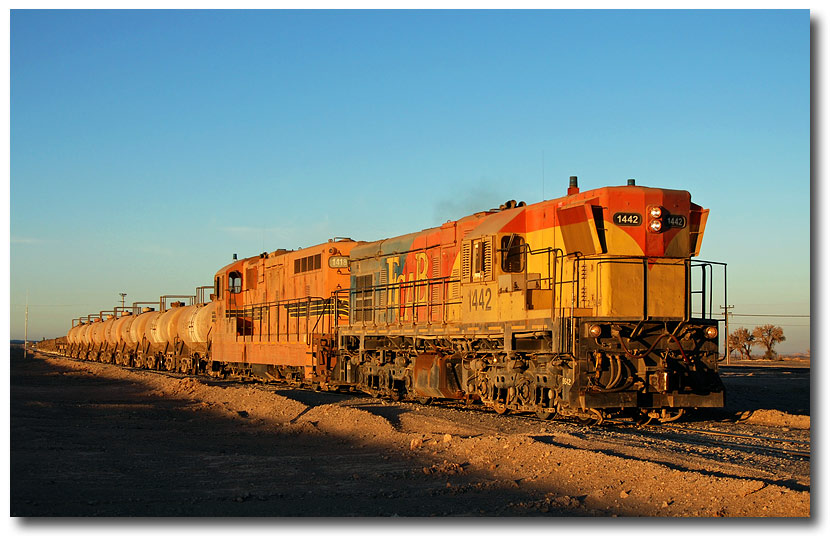 |
|
In
the first morning light, a freight from Mejillones had
reached Calama at an altitude of 2250 m/ 7380 ft. The majority of trains
are bound for Chuquicamata, a few miles north of the city,
where there is one of the largest copper mines of the world, producing
630'000 tons anually. Its largely thanks to this mine that Chile
is the biggest copper producer in the world. Copper accounts for about
one third of Chile's exports. Taking the soaring world market price in
recent years into account, you can imagine how these copper mines
vitually pump truckloads of money into the country's economy year for
year. 15.12.2009
Im ersten Licht eines Tages
erreichte ein Zug aus Mejillones die Stadt Calama, welche bereits auf 2250m.ü.M. liegt. Die meisten der Züge fahren nach Chuquicamata
einige Kilometer nördlich der Stadt, wo sich
eine der grössten Kupferminen der Welt befindet. Dank Chuquicamata,
das alleine 630'000 Tonnen jährlich produziert und weiteren Minen der
Region ist Chile der grösste
Kupferproduzent Weltweit, was rund ein drittel der
Exporterlöse des gesamten Landes ausmacht. Wenn man zudem die stark angestiegenen Weltmarktpreise
für Kupfer in den
vergangenen Jahren vor Augen hält, kann man sich vorstellen, wie
diese Minen im abgelegenen Norden Jahr für Jahr praktisch
Lastwagenladungen voll Geld in die Chilenische Wirtschaft pumpen.
|
|
|
|
|
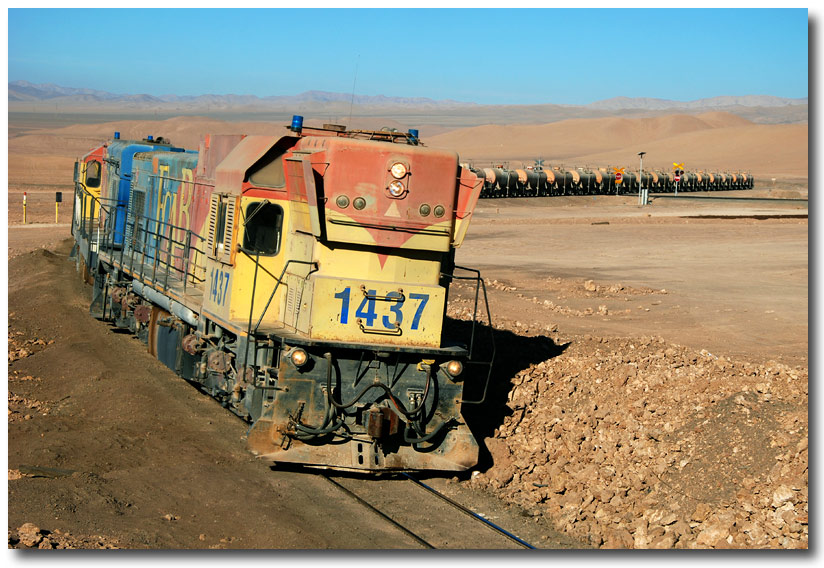 |
|
Desert
Railroad: #1437 was
one of seven G12 and G22 units originally built in Australia under EMD
license for Westrail (WAGR). After purchase, FCAB modified them for the harsh
conditions in the Atacama Desert. Picture taken
between O'Higgins and Portezuelo. 11.12.2009
Eisenbahn
der Wüste: Lok 1437 war eine von
sieben G12/ G22,
die ursprünglich für Westrail under EMD Lizenz in Australien gebaut
wurden. Die FCAB modifizierte die Lokomotiven nach der Übernahme für
den harten Einsatz in der Atacama Wüste. Die Aufnahme entstand
zwischen O'Higgins und Portezuelo. |
|
|
|
|
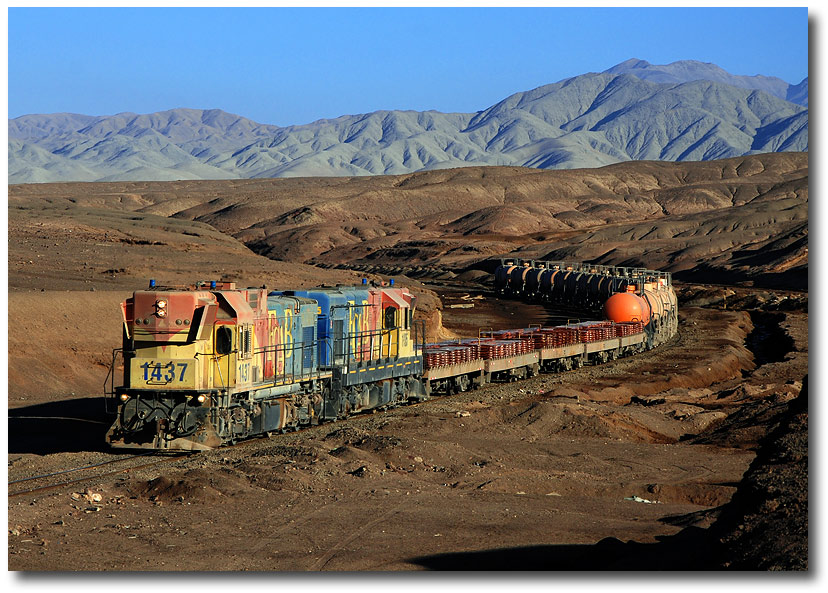 |
|
Trains
from the mines in the desert back to the ports of Antofogasta and
Mejillones move the produced copper cathodes on flat cars and empty tank cars.
The copper is then unloaded and shipped in Antafogasta, whereas the tank cars
proceed to Mejillones to a dedicated interacid-terminal.
Picture taken near La Negra, 11.12.2009
Die Züge befördern die
produzierten Kupfer-Kathoden auf Flachwagen und leere Tankwagen von den Minen zu den
Pazifikhäfen von Antofagasta und Mejillones. Der Kupfer wird
schliesslich in Antofagasta entladen und verschifft, während die Kesselwagen nach
Mejillones weiterbefördert werden, wo ein spezielles Interacid-Terminal zur Verladung der
Chemikalien zur Verfügung steht. Das Bild entstand
unweit La Negra. 11.12.2009
|
|
|
|
|
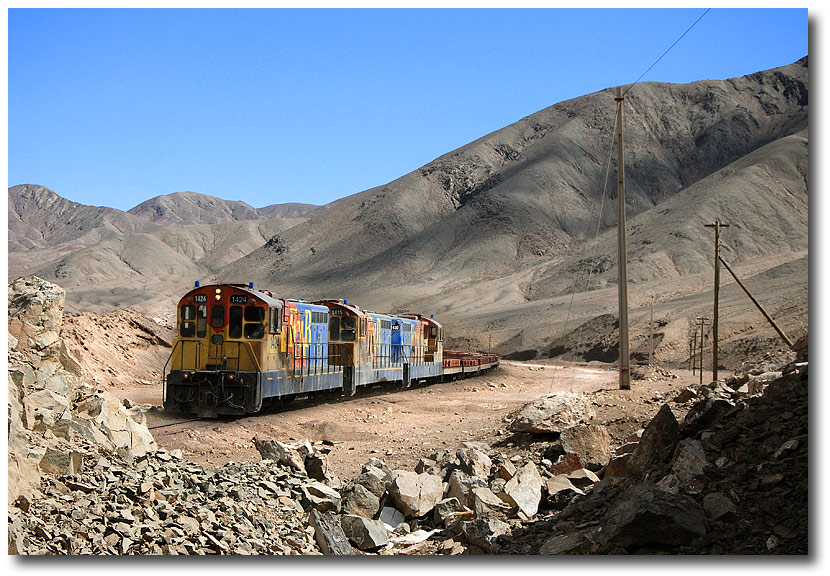 |
|
Between La
Negra and Antofagasta, the line follows a rocky valley. Three former
Canadian National GM NF210's ex. Newfoundland, in Chile also referred
as "Quaanaac", lead a westbound downhill. The units
were built by EMD between 1953 and 1960. 12.12.2009 Zwischen
La Negra und Antofagasta folgt die Strecke einem felsigen Tal. Drei
ex. Canadian National GM NF210 (Co'Co') aus Neufundland, durch das
Chilenische Personal auch "Quaanaac" genannt, führen einen
westwärts fahrenden Zug zu Tal. Die Lokomotiven wurden zwischen
1952 and 1960 durch EMD gebaut. 12.12.2009
|
|
|
|
|
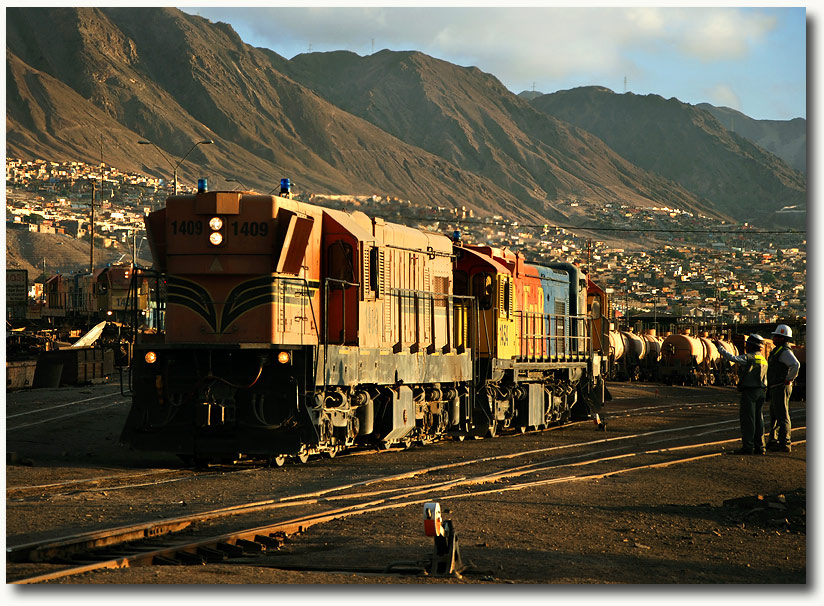 |
|
The
headquarters and main
workshops of the FCAB are located in Antofogasta, which is the operational
centre of the
railway. The line
towards La Negra Pass in the south is even double tracked for the
first few miles - a relict from the steam era, when express
trains on the longitude railway all the way down to Santiago
and the international passenger over the Socompa Pass to Argentina
(see this marvelous movie
clip and pics
from the steam era) shared FCAB tracks on this section.
On the northern side of the large
Antofogasta yards, a freight leaves towards Mejillones. 11.12.2009
Antofagasta ist das betriebliche
Zentrum der FCAB mit Bahnverwaltung, Hauptwerkstätten und zahlreichen
hier beginnenden oder endenden Zügen. Die Strecke Richtung La Negra
Pass ist für einige Kilometer sogar zweigleisig ausgebaut -
ein Relikt aus der Dampfzeit, als auch die Züge der Längsbahn
ins 1200km entfernte Santiago und der internationale Pasajero über
den Socompa Pass nach Argentinien
diesen Abschnitt
mitbenutzten (Siehe dazu diesen grossartigen Film
aus Argentinien und Bilder
vom Socompa Pass zur Dampfzeit!).
Ein Güterzug
verlässt die ausgedehnten Anlagen auf der Gegenseite des Bahnhofs
Richtung Mejillones.
|
|
|
|
|
|
www.RailPictures.net/ |
See the
FCAB pictures of my friend Jean-Marc Frybourg
taken on the same trip. |
|
www.fcab.cl/
|
The
official website of Ferrocarril Antofagasta a Bolivia FCAB,
belonging to Antofogasta P.L.C. |
|
www.Youthube.com/
|
Watch
hard working EMD's from FCAB and FERRONOR with an acid train climbing
to cumbre between Mejillones and Prat. |
|
(c) Markus Fischer,
Zuerich |
|
|





